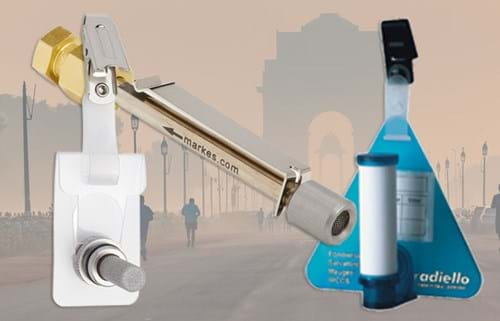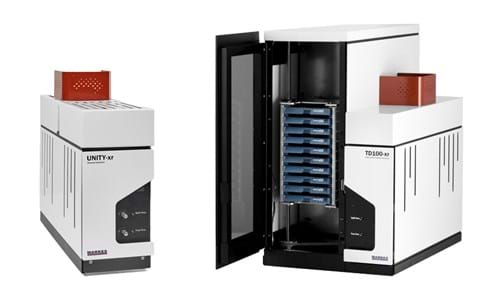IS 5182-27 is a standard method for monitoring volatile organic compounds (VOCs) in air, using diffusive sampling and thermal desorption–GC–MS. It is designed for assessing air quality in ambient, indoor, and workplace environments.
Why is IS 5182-27 important?
In response to the increasingly hazardous levels of air pollution in India, the Bureau of Indian Standards (BIS) has established IS 5182-27, a standard designed to support the monitoring and analysis of vapour-phase volatile organic compounds (VOCs) that contribute to this air pollution. This method employs diffusive (passive) sampling techniques to detect a broad spectrum of VOCs, ranging from vinyl chloride to C22 hydrocarbons, in ambient air and gaseous emissions.

Moving away from the older IS 5182-11
IS 5182-27 represents a major advancement in air quality monitoring in India. It moves away from traditional solvent extraction methods (as outlined in IS 5182-11) in favour of thermal desorption (TD) combined with gas chromatography–mass spectrometry (GC–MS). This transition enables more comprehensive detection of hazardous compounds in the air ranging from vinyl chloride to C22 hydrocarbons.
What is the methodology described in IS 5182-27?
- Monitoring stations use diffusive samplers to collect air samples without the need for pumps.
- Three types of samplers can be used: axial sorbent tubes, radiello®, and POD (Fast-PAS) samplers. Sampling durations range from 1–2 weeks for ambient monitoring to 4–8 hours for workplace assessments.
- Collected samples are analysed using TD, a highly sensitive and solvent-free technology, followed by GC–MS. This approach facilitates the detection of a wide range of volatile organic compounds.
How does IS 5182-27 compare with IS 5182-28?
IS 5182-27 and IS 5182-28 are both modern updates to the earlier IS 5182-11 method, replacing solvent extraction with thermal desorption and GC–MS for more sensitive and sustainable monitoring of volatile organic compounds (VOCs). While they share a common analytical approach, the two methods differ in how samples are collected.
IS 5182-27 uses passive (diffusive) sampling, where sorbent tubes are positioned at the sampling site and exposed to air for a defined period. VOCs diffuse naturally onto the sorbent without the need for pumps or electricity. This technique is ideal for long-duration, unattended monitoring in settings such as indoor environments, personal exposure studies or remote ambient locations.
IS 5182-28 uses active (pumped) sampling, where air is drawn through a sorbent tube using a calibrated pump. This method enables controlled collection of larger sample volumes in shorter timeframes, offering higher sensitivity and time-resolved data. It is well suited to occupational hygiene assessments, source emission monitoring and applications requiring rapid or short-duration sampling.
Together, these methods provide a flexible toolkit for VOC monitoring across a wide range of real-world scenarios – allowing users to choose the most appropriate option based on site constraints, required sensitivity and sampling duration.
What are the advantages of IS 5182-27?
- Measure a broader analyte range: Detect a wide range of harmful VOCs across different environments, including ambient air, indoor spaces, and workplaces. IS 5182-27 covers an extensive range of VOCs, such as aliphatic and aromatic hydrocarbons, industrial solvents, and fuel components, many of which were not measurable using the older method, IS 5182-11.
- Higher sensitivity & more accurate results: IS 5182-27 provides up to 1000 times greater sensitivity than solvent-extraction methods (IS 5182-11), enabling precise VOC measurement. Time-weighted average (TWA) concentrations give more accurate results of long-term exposure.
- Solvent-free: IS 5182-27 eliminates the use of hazardous solvents, reducing environmental impact and health risks.
- Simple sampling protocols: Diffusive sampling requires no electricity and is straightforward to implement and monitor.
- Cost-effective: Operational costs are lowered by eliminating the need for solvents, cryogens, and pumps.
Products to support IS 5182-27 compliance
Markes manufactures and supplies all the products required for IS 5182-27 compliance. These include:
- UNITY-xr: Advanced thermal desorption system offering exceptional sensitivity.
- TD100-xr: High-throughput thermal desorption system for comprehensive air monitoring.
- Samplers: Comprehensive options, including sorbent tubes, radiello samplers, and POD (Fast-PAS) samplers.
- Cold traps and accessories: Essential add-ons to support and optimise TD system performance.

Relevant products
Further information
- On-demand webinar: The invisible toxic air we breathe (Presenter: Dr Sushil k. Tyagi)
- E-book: What is thermal desorption and how does it help air quality monitoring?
- Blog: Passive sampling in the workplace – Why thermal desorption is replacing solvent extraction
- Infographic: Solvent extraction vs. thermal desorption – Key considerations when looking to switch
- Application note: A review of sorbent-based sampling methods for volatile and semi-volatile organic compounds in air
- Blog: How long do sorbent tubes for thermal desorption last?
- News: Markes International and SepSolve Analytical play pivotal part in Delhi’s new ‘supersite’ air quality station
Acknowledgement
Markes International acknowledges the invaluable contributions of Dr S.K. Tyagi, former Additional Director at the Central Pollution Control Board (CPCB), Ministry of Environment, Forest and Climate Change, Government of India, in the development of the Indian Standard Method IS 5182-27. With over 35 years of experience in air quality research and a distinguished career marked by significant achievements, including the establishment of the Air Toxic Laboratory at CPCB and contributions to the phase-out of lead in petrol, Dr Tyagi has been instrumental in shaping air quality standards in India. As a consultant for Markes International, Dr Tyagi’s expertise continues to drive advancements in thermal desorption technology and its applications for air quality monitoring in India.
Questions about IS 5182-27?
Our team is here to provide expert advice on air monitoring, and guidance on method setup, system configuration, and troubleshooting for IS 5182-27, to ensure compliance and data quality.




